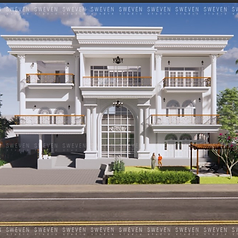Contact : +91 9632587562
Sustainable Architecture: A Guide to Green Building Practices
In today’s era of heightened environmental awareness, sustainable architecture has become a pivotal aspect of modern design. Sustainable architecture, often referred to as green building or eco-friendly design, focuses on minimizing the environmental impact of buildings through innovative design and construction techniques. The goal is to create spaces that are not only aesthetically pleasing but also energy-efficient, resource-conscious, and supportive of human well-being.
What is Sustainable Architecture?
Sustainable architecture involves designing buildings that reduce energy consumption, use sustainable materials, and minimize waste. This approach is grounded in principles of environmental responsibility and resource efficiency. Sustainable architecture encompasses a variety of practices, including energy-efficient systems, sustainable materials, and designs that enhance natural light and ventilation.
Key Principles of Sustainable Architecture
-
Energy Efficiency: One of the core principles of sustainable architecture is reducing energy consumption. This can be achieved through the integration of energy-efficient systems such as LED lighting, high-performance windows, and advanced HVAC systems. Incorporating renewable energy sources like solar panels or wind turbines further enhances a building’s sustainability.
-
Sustainable Materials: The choice of materials plays a crucial role in sustainable architecture. Utilizing locally sourced, recycled, or rapidly renewable materials reduces the carbon footprint associated with transportation and manufacturing. Materials such as bamboo, reclaimed wood, and low-VOC (volatile organic compounds) paints contribute to a healthier indoor environment.
-
Water Conservation: Sustainable architecture also emphasizes water conservation through the use of efficient plumbing fixtures, rainwater harvesting systems, and drought-tolerant landscaping. These measures help in reducing water consumption and managing runoff, contributing to overall environmental sustainability.
-
Indoor Environmental Quality: Creating a healthy indoor environment is a significant aspect of sustainable architecture. This involves improving air quality through proper ventilation, using non-toxic materials, and ensuring adequate natural light. A well-designed indoor environment enhances the well-being and productivity of occupants.
-
Site Responsiveness: Sustainable architecture considers the building’s impact on its surrounding environment. Site responsiveness involves designing buildings that harmonize with the local climate, landscape, and ecosystems. This includes orienting the building to maximize natural light, utilize natural ventilation, and reduce heat gain.
Benefits of Sustainable Architecture
-
Environmental Impact: Sustainable architecture significantly reduces the environmental impact of buildings by lowering energy consumption, minimizing waste, and conserving natural resources. This contributes to reducing greenhouse gas emissions and mitigating climate change.
-
Economic Savings: While sustainable buildings may have higher upfront costs, they offer substantial long-term savings through reduced energy and water bills. Additionally, green buildings often have lower maintenance costs and higher property values.
-
Health and Well-being: Sustainable architecture enhances the quality of life for occupants by providing healthier indoor environments. Improved air quality, natural lighting, and thermal comfort contribute to better physical and mental health.
-
Innovation and Aesthetics: Sustainable architecture encourages innovative design solutions and creative use of materials. This results in aesthetically pleasing buildings that stand out for their environmental consciousness and functional design.
Conclusion
Sustainable architecture is more than a trend; it is a necessary approach to designing buildings that meet the needs of today while preserving resources for future generations. By focusing on energy efficiency, sustainable materials, water conservation, indoor environmental quality, and site responsiveness, architects can create buildings that are both beautiful and environmentally responsible. As the demand for green buildings continues to grow, sustainable architecture will play a crucial role in shaping a more sustainable future.
